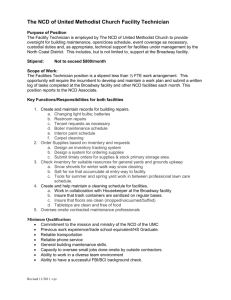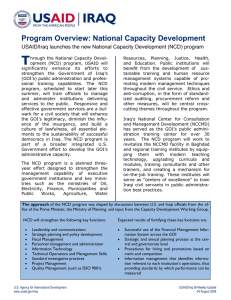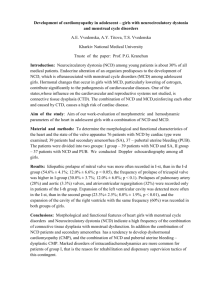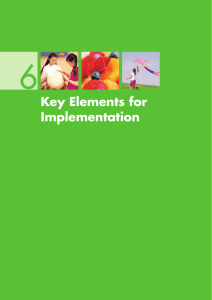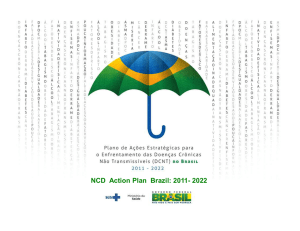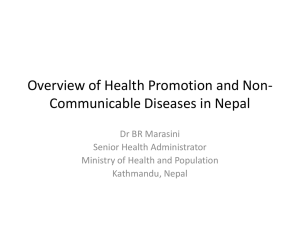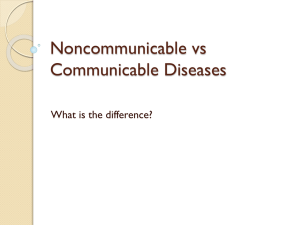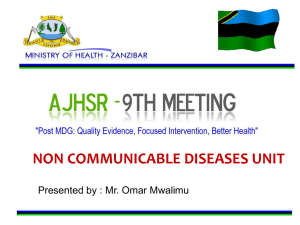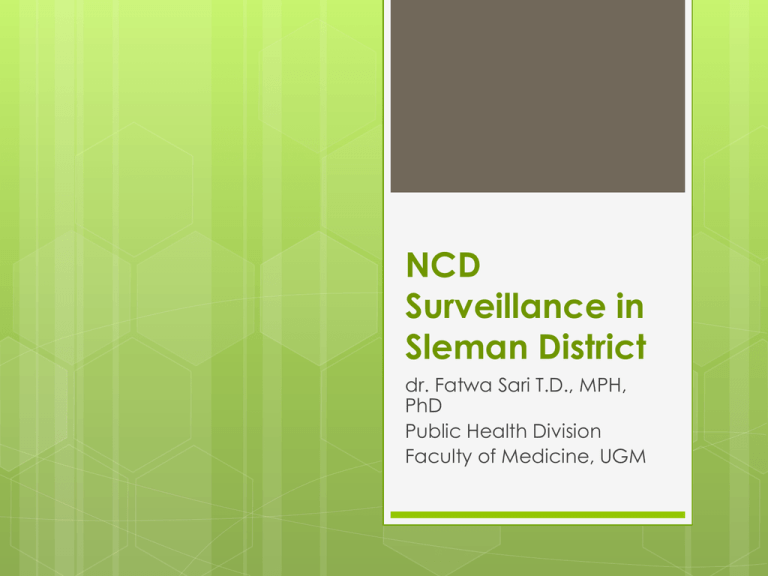
NCD
Surveillance in
Sleman District
dr. Fatwa Sari T.D., MPH,
PhD
Public Health Division
Faculty of Medicine, UGM
Background: Increasing the
prevalence of NCD in Indonesia
%
Maternal/
Perinatal
Communicable
Diseases
Non-communicable
diseases
Injury
Source: Riskesdas 2007
Disease prevalence in Indonesia
and in Yogyakarta Province
Prevalence (%)
Risk
factors/disease
Smoking
Physical
inactivity
Low fruit and
vegetable intake
Alcohol drinking
Hypertension
Heart diseases
Stroke
Diabetes
Tumor
Yogyakarta
Province
Lowest
Prevalenc
e
Highest
prevalenc
e
29
30
26
34
48
45
27
62
94
4.6
32
7.2
0.8
1.1
0.4
86
3.2
36
7.3
0.8
1.6
0.9
86
0.4
20
2.6
0.4
0.4
1.5
98
14.9
40
12.6
1.7
2.6
0.9
Indonesia
Source: Riskesdas 2007
Causative factors for NCD
Environmental risk
factors
•
•
•
•
•
Globalization
Urbanization
Poverty
Low
education
Stress
Behavioral
risk factors
•
•
•
•
Unhealthy diet
Physical
inactivity
Tobacco use
Harmful use of
alcohol
Biological
risk factors
•
•
•
•
•
High blood
glucose
Hypertension
Abnormal
serum lipids
Abnormal
waist/hip ratio
Abnormal
lung function
WHO: Monitoring the progress of NCD in LMIC
NCD
•
•
•
•
•
Heart disease
Stroke
Diabetes
Chronic
respiratory
disease
Cancer
Goal:
To develop a surveillance system of NCD
risk factors to monitor the progress of
NCD in Yogyakarta
• Provides evidence based intervention
for policy maker
• Encourages networking in NCD
control and prevention
• Facilitates research in NCD areas
Methodology
Methodology
Sleman
District
Population
: 15 – 75 yrs old
Total sample : 3600
Based on WHO STEPS guideline
Consideration:
sex
and age group/stratum
20% non response
Sample size
Table 1. Minimal sample size for NCD risk factor’s survey
Sample size of each group
Sex
15-24yr 25-34yr 35-44yr 45-54yr 55-64yr 65-75yr
Male
250
250
250
250
250
250
Female
250
250
250
250
250
250
Total = 3000 + 20% non response = 3600
Sampling method
Scenario
2 – WHO STEPS sample design
Multi-stage cluster sampling- PPS
Cluster based on dusun (hamlet)
Number of cluster = 10% of total hamlet(1221)
Stage
1st = cluster selection
2nd = household selection
STEPS sampling software
STEPS sampling software
3rd = respondent/participant selection
Kish respondent selection
1 household 1 respondent
Population, samples and sampling
design (STEPwise guidance)
Population
(1212 hamlet)
Random selection
of 10% of hamlets
Proportionate to
size random
selection of
households
Random selection
of 3600
respondents
•Adult (15-75 years)
•No physical disability
•122 hamlets
•1100 households
•Develop a sampling list from selected
households
•3600 respondents
Variable
Demographic
Risk
Tobbaco use
Alcohol consumption
Types of activity
Sedentary lifestyle
Physical
examination
Height, weight, waist circumference, blood
pressure
Instrument
WHO
STEPS Instrumen – translate-Indo
version
STEPwise instrument core version (WHO,
2006)
The plan of data collection
Baseline
survey
September
2014
Repeated
cross-section
II
Repeated
cross-section
III
2019
2024
....
Data analysis
Minimum number of
respondents= 3000
Sex
15(years)
25(years)
35(years)
45(years)
55(years)
65-75
(years)
Men
250
250
250
250
250
250
Women
250
250
250
250
250
250
35(years)
45(years)
55(years)
65-75
(years)
Weighted by number of
population by sex and agegroups in certain year
Sex
Men
Women
15(years)
25(years)
The prevalence of NCD risk factors in
Yogyakarta city, 2004 and 2009
Man
Woman
Overweight & obese
Elevated blood pressure
2004
Physical inactivity
2009
Smoking*
Low fruit and…
0% 20% 40% 60% 80% 100% 0%
50%
100%
The prediction of people at high risk of
getting CVD according to sex and SES
12%
10%
8%
Man*
Woman
6%
Low SES*
High SES*
4%
2%
0%
2004
2009
The initiation of men and women at high risk of getting
CVD in Yogyakarta city year 2004 and 2009
Man
Woman
80%
80%
70%
70%
60%
60%
50%
50%
40%
40%
2004
30%
30%
2009
20%
20%
10%
10%
0%
0%
15-
25-
35-
45-
55-
65-
Age groups
15-
25-
35-
45-
55-
65-
Age groups

